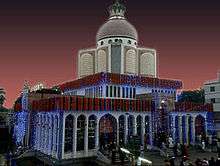Syed Ahmad Ullah
Syed Ahmad Ullah (or Syed Ahmad Ullah Maizbhandari) (14 January 1826 - 23 January 1906) was a Bangladeshi Sufi saint and founder of the Maizbhandari Sufi Order, the first such order to originate in Bangladesh.[1]
Syed Ahmad Ullah সৈয়দ আহমদ উল্লাহ | |
|---|---|
 Shrine of Syed Ahmed Ullah Maizbhandari | |
| Personal | |
| Born | 14 January 1826 |
| Died | 23 January 1906 Maizbhandar |
| Resting place | Maizbhandar |
| Religion | Islam |
| Flourished | Islamic golden age |
| Children | Syeda Badiunnessa Bibi, Syed Fazul Haque, Syeda Anwarunnesa |
| Parents | Father: Syed Motiullah Maijabhandari, mother: Syeda Khayrunnesa |
| Denomination | Sunni |
| School | Hanafi, Qadiriyya |
| Order | Maizbhandari Order |
| Founder of | Tarika-e-Maizbhandari |
Birth and family chain
In 1826, Syed Ahmad Ullah Maizbhandari was born in Maizbhandar, Chittagong in Bangladesh.[2] His father was Syed Motiullah Maizbhandari and mother was Syeda Khayrunnesa. Ahmad Ullah's predecessor Syed Hamid Uddin, was appointed as the imam and judge in Gauda. Because of the epidemic in Gauda, he settled in Kanchannagar of Patiya thana in Chittagong. [2] One of his sons, Syed Abdul Quader was appointed as the imam in Fatikchhari. His great grandson Syed Motiullah settled in Maizbhander.
Tarika-e-Maizbhandari
Ahmad Ullah founded the Tarika-e-Maizbhandari or the Maizbhandari Sufi order, a Sufi Tariqa (religious order) based in Chittagong District.[3][4][5][6][7] A research report prepared by the Migration Review Tribunal (MRT) and Refugee Review Tribunal (RRT) of Australia reported the order today has over ten million followers.[8]
Saifuddin Ahmad Maizbhandari is the order's current leader.[9]
According to German scholar Hans Harder, the order based in Maijbhandar "is a powerful religious institution whose very popularity and influence defy any notions of marginality. It has been able to draw adherents from all sections of society, including the urban middle class, and have managed to assert their perspective on Islam vis-à-vis pressure from reformist quarters while keeping in touch with the religious mainstream in Bengal."[3]
In terms of literature, there has been "a sizeable textual output from within the movement since the beginning of the twentieth century, including hagiographies and theological treaties, in the form of monographs, leaflets and journals". [3]
The order is known for its gatherings for spiritual listening and devotional music, which are important in Bengali Sufi traditions.[10][11] There are over 10,000 such songs, transmitted orally at first but now on CD and video, and they have come to form their own distinct genre of music in Bangladesh. [3]
References
- "Life of Gausul Azam Hazrat Ahmad Ullah Maizbhandari". maizbhandarsharif.com/. Archived from the original on 17 May 2019.
- Harder, Hans (2011), Sufism and Saint Veneration in Contemporary Bangladesh: The Maijbhandaris of Chittagong, Routledge, p. 22, ISBN 978-1-136-83189-8
- Harder, Sufism and Saint Veneration in Contemporary Bangladesh, p. 15
- "মাইজভান্ডার দরবার শরীফ" [Maizbhandar Darbar Sharif], fatikchhari.chittagong.gov.bd, retrieved 9 May 2020
- Ali, Syed Murtaza (1971). Saints of East Pakistan. Oxford University Press, Pakistan Branch. p. 23.
- Contributions to Indian Sociology. Mouton. 2006.
- Pakistan Quarterly. Pakistan Publications. 1964. p. 129.
- Research & Information Services Section of the Refugee Review Tribunal (RRT) [Australia] (18 August 2008), RRT Research Response. Country: Bangladesh (PDF), U.S. Department of Justice, BGD33602
- "Saifuddin Ahmed Maizbhandari calls for spreading Sufi messages for global harmony". Bangladesh Sangbad Sangstha (BSS). 22 February 2020. Retrieved 4 May 2020.
- Alam, Sarwar (2019-08-19). Cultural Fusion of Sufi Islam: Alternative Paths to Mystical Faith. Routledge. ISBN 978-0-429-87294-5.
- Dey, Amit (2005). The Image of the Prophet in Bengali Muslim Piety, 1850-1947. Readers Servic. ISBN 978-81-87891-34-5.